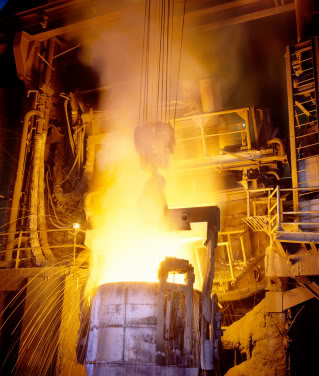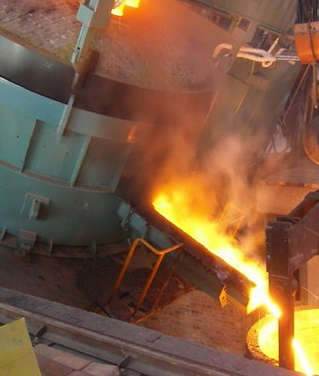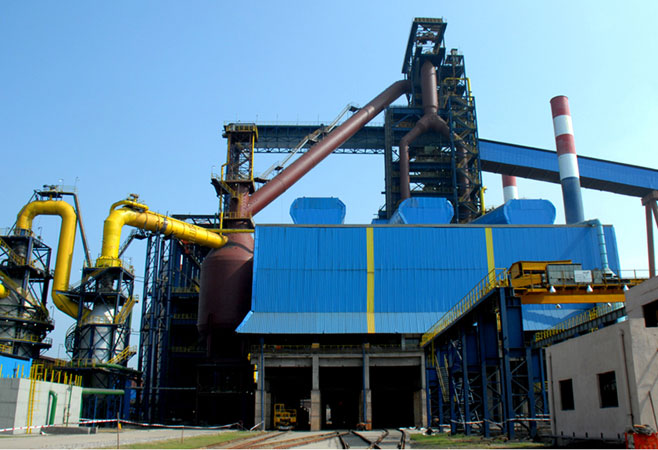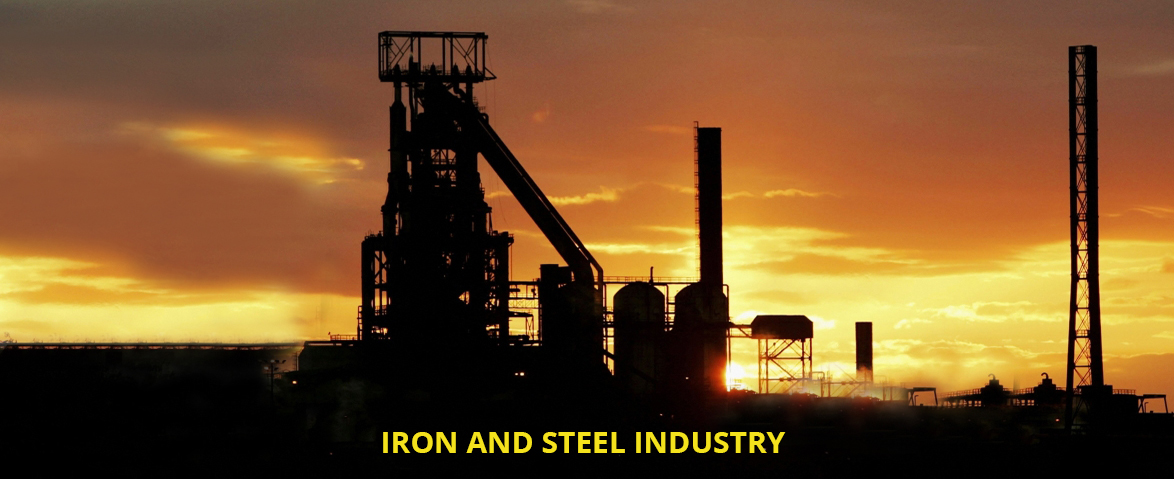Iron and Steel
Direct reduction of iron
Direct reduction of iron Sponge iron is the product of solid state reduction of iron ore. It is also known as directly reduced iron (DRI). The process of manufacturing sponge iron or DRI is known as DR process.
Rotary kiln process is a well established process for production of sponge iron. In this process a refractory lined rotary kiln is used for reduction of iron ore in solid state. A central burner located at the discharge end is used for initial heating of the kiln. Sized iron ore is continuously fed into the kiln along with coal. Small quantities of limestone/dolomite are added to scavenge the sulphur from the coal.
Major equipments for the process are
- Rotary kiln
- Rotary cooler
- Waste heat recovery system
- Magnetic separator
- Conveyors
Power generation
One of the biggest advantages in coal based sponge iron manufacture is the generation of electric power through waste gases at very low cost and this is proving to be equally profitable as the sale of sponge iron. This means that electrical power could become a major product along with sponge iron. As power tariff is high in most of the Indian states, the units can sell power and earn additional revenue or save on energy cost, if used internally.
Electric arc furnace
Electric arc furnace  Steel making in electric arc furnace has emerged as an important steel making process in recent years. The flexibility and easy adoptability of EAF steelmaking to accommodate the fluctuating market demand have evolved into the concept of mini steel plants to produce different grades of finished products. Although scrap is the preferred raw material but sponge iron and iron carbide are being used regularly in most plants because of shortage of steel scrap and to dilute the concentration of tramp elements. Several developments in the design and operation have made EAF steelmaking to contribute significantly to the overall total production of steel in the world. It must be noted that EAF consumes lot of electric energy and hence the cost and availability of electrical power are important issues in electric steel development.
Steel making in electric arc furnace has emerged as an important steel making process in recent years. The flexibility and easy adoptability of EAF steelmaking to accommodate the fluctuating market demand have evolved into the concept of mini steel plants to produce different grades of finished products. Although scrap is the preferred raw material but sponge iron and iron carbide are being used regularly in most plants because of shortage of steel scrap and to dilute the concentration of tramp elements. Several developments in the design and operation have made EAF steelmaking to contribute significantly to the overall total production of steel in the world. It must be noted that EAF consumes lot of electric energy and hence the cost and availability of electrical power are important issues in electric steel development.
The electric arc furnace is used to reduce iron from iron ore. Heat is generated from an electric arc between electrodes. Oxygen is blown into the furnace, and lime and other materials are added to combine with the impurities and form slag. Molten iron is extracted and poured out via a tapping spout. It is then processed again in an electric arc furnace to make steel – particularly special quality steel.
 Melting : The melting period is the heart of EAF operations. The EAF has evolved into a highly efficient melting apparatus and modern designs are focused on maximizing the melting capacity of the EAF. Melting is accomplished by supplying energy to the furnace interior. Electrical energy is supplied via the graphite electrodes and is usually the largest contributor in melting operations.
Melting : The melting period is the heart of EAF operations. The EAF has evolved into a highly efficient melting apparatus and modern designs are focused on maximizing the melting capacity of the EAF. Melting is accomplished by supplying energy to the furnace interior. Electrical energy is supplied via the graphite electrodes and is usually the largest contributor in melting operations.
Refining : Refining operations in the electric arc furnace have traditionally involved the removal of phosphorus, sulphur, aluminium, silicon, manganese and carbon from the steel. Refining operations were carried out following meltdown i.e. once a flat bath was achieved. At the end of refining, a bath temperature measurement and a bath sample are taken for further processing.
De-slagging : De-slagging operations are carried out to remove impurities from the furnace. During melting and refining operations, some of the undesirable materials within the bath are oxidized and enter the slag phase. The furnace is tilted backwards and slag is poured out of the furnace through the slag door. Removal of the slag eliminates the possibility of phosphorus reversion.
Transformer power : Electric furnaces are powerful consumers of electric energy. The furnace transformer transforms high voltage energy into low voltage. The melting process consists of two periods: meltdown and refining period. In melt down period higher electric energy is required as compared with the refining period. In small furnaces, the power consumption for melting is about 600kWh⁄ton and it falls to 450kWh/ton in big furnaces.
Blast furnace
Blast furnace  The purpose of a blast furnace is to chemically reduce and physically convert iron oxides into liquid iron called "hot metal".
The purpose of a blast furnace is to chemically reduce and physically convert iron oxides into liquid iron called "hot metal".
The blast furnace is a huge, steel stack lined with refractory brick, where iron ore, coke and limestone are dumped into the top, and preheated air is blown into the bottom. The raw materials require 6 to 8 hours to descend to the bottom of the furnace where they become the final product of liquid slag and liquid iron. These liquid products are drained from the furnace at regular intervals. The hot air that was blown into the bottom of the furnace ascends to the top in 6 to 8 seconds after going through numerous chemical reactions. Once a blast furnace is started it will continuously run for four to ten years with only short stops to perform planned maintenance.
- Iron oxides can come to the blast furnace plant in the form of raw ore, pellets or sinter. The raw ore is removed from the earth and sized into pieces that range from 0.5 to 1.5 inches. This ore is either Hematite (Fe2O3) or Magnetite (Fe3O4) and the iron content ranges from 50% to 70%.
- This iron rich ore can be charged directly into a blast furnace without any further processing. Iron ore that contains a lower iron content must be processed or beneficiated to increase its iron content.
- The iron ore, pellets and sinter then become the liquid iron produced in the blast furnace with any of their remaining impurities going to the liquid slag.
- The coke contains 90 to 93% carbon, some ash and sulphur but compared to raw coal is very strong. The strong pieces of coke with a high energy value provide permeability, heat and gases which are required to reduce and melt the iron ore, pellets and sinter.
- Since the limestone is melted to become the slag which removes sulphur and other impurities, the blast furnace operator may blend the different stones to produce the desired slag chemistry and create optimum slag properties such as a low melting point and a high fluidity.
- All of the raw materials are stored in an ore field and transferred to the stock house before charging. Once these materials are charged into the furnace top, they go through numerous chemical and physical reactions while descending to the bottom of the furnace.
- The iron ore, pellets and sinter are reduced which simply means the oxygen in the iron oxides is removed by a series of chemical reactions.
- At the same time the iron oxides are going through these purifying reactions, they are also beginning to soften then melt and finally trickle as liquid iron through the coke to the bottom of the furnace.
In summary, the blast furnace is a counter-current realtor where solids descend and gases ascend. In this reactor there are numerous chemical and physical reactions that produce the desired final product which is hot metal.
Getin touch

Fe Techno Engineering and Power Solutions.
#20, Lakshmi, 3rd floor,Shankarmutt Road
Shankarapuram, Basavangudi, Bangalore – 560004.
Tel: +91-9611441967, 9341104574, 9379013917
Landline: 080 - 4096004
Email: info@fetechno.com
.png)




